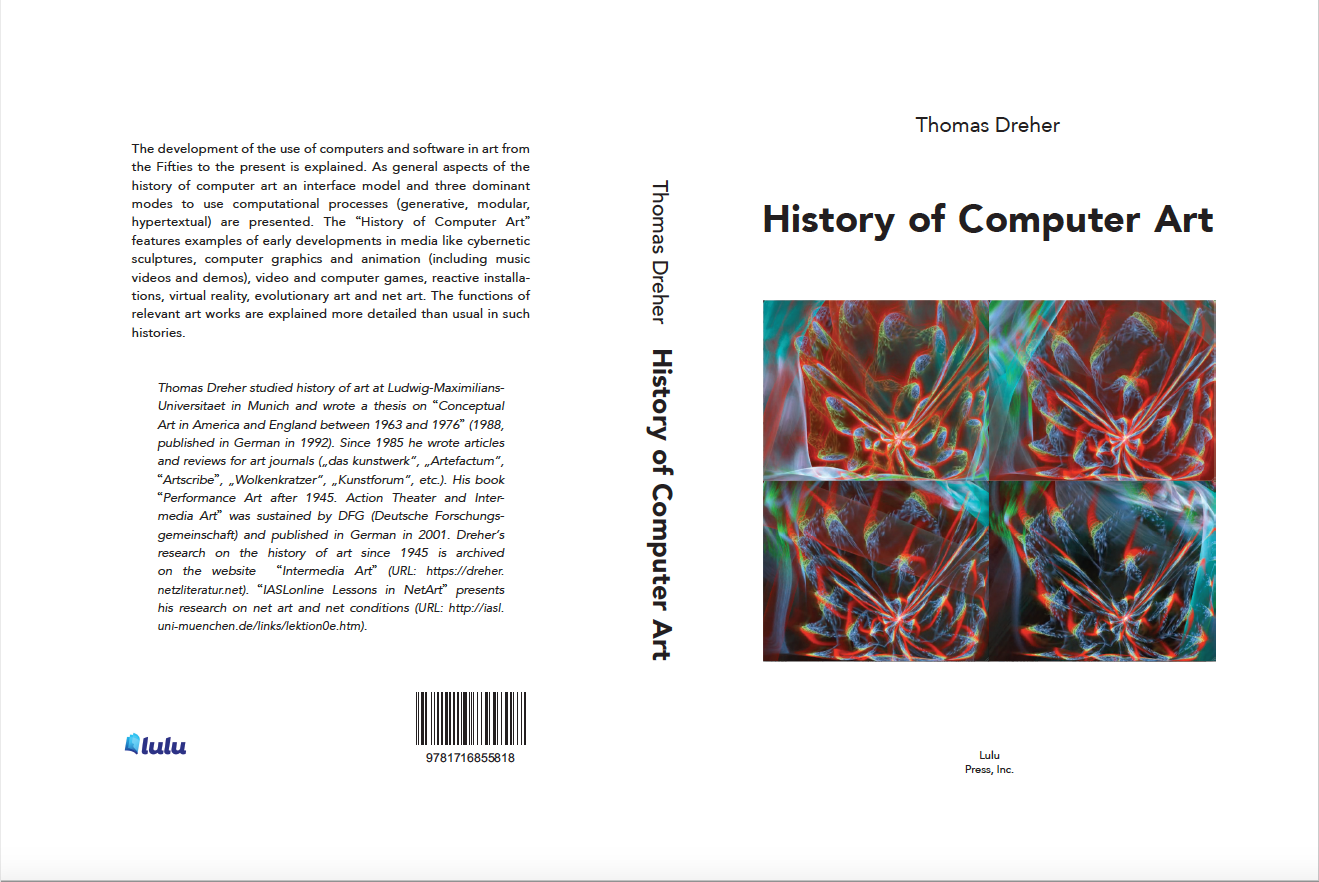IASLonline NetArt: Theory
Thomas Dreher
History of Computer Art
all chapters with links in one PDF file
Between October 2011 and December 2012 the German version was published in the internet chapter for chapter in the sequence of the table of contents. From August 2013 to June 2014 the English translation was published in the same way. The first update was edited in September 2015.
Table of Contents
I. Introduction
II. Cybernetics
II.1 Basics
of Cybernetics
II.1.1 Ballistics
II.1.2 Stochastics
II.1.3 Information
II.1.4 Feedback
II.1.5 Homeostasis
II.2 Cybernetic
Models
II.2.1 Homeostat
II.2.2 Memory
II.2.3 Path Finding
II.3 Cybernetic
Sculptures
II.3.1 Pioneer Works
II.3.1.1 Gordon Pask´s "Musicolour System"
II.3.1.2 Nicolas Schöffer´s "CYSP 1"
II.3.2 "Cybernetic Serendipity"
II.3.2.1 The Exhibition in London
II.3.2.2 Edward Ihnatowicz´s "SAM" and "Senster"
II.3.2.3 Gordon Pask´s "Colloquy of Mobiles"
II.3.3 Light and Sound Installations of James Seawright and Vladimir Bonacic
II.3.4 Nicolas Negroponte, the Architecture Machine Group and "Seek"
III. Information aesthetics
III.1 Computer Literature
III.1.1 Word Processing
III.1.2 Christopher Strachey´s "Love-letters"
III.1.3 Stochastic Texts
III.2 Computer Graphics
III.2.1 Analog Graphics
III.2.2 Digital Computer Graphics
IV. Images in Motion
IV.1 Video Tools
IV.1.1 Video Cultures
IV.1.2 Video Synthesizers
IV.2 Computer
Animation
IV.2.1 The Development from the Sixties to the Eighties
IV.2.1.1 An Outline
IV.2.1.2 The Sixties
IV.2.1.3 The Seventies
IV.2.1.4 The Eighties
IV.2.1.4.1 Film Sequences
IV.2.1.4.2 Music Videos
IV.2.1.4.3 Demoscene
IV.2.1.4.4 The Techno-Imaginary
IV.3. Evolutionary
Art
IV.3.1 Biomorphs
IV.3.2 Evolution and Processing
IV.3.3 Fractal Flames
IV.3.4 Emergence
V. Reactive Installations and Virtual Reality
V.1 Operations
of Observers on the Interface to the Image Simulation
V.2 Seamless
Total Simulation versus Interface Architecture
VI. Net Art: Networks, Participation, Hypertext
VI.1 Computer Networks
VI.1.1 From Timesharing to the Internet
VI.1.2 Participation in Networks of the Eighties
VI.2 Hypertext
VI.2.1 "As We May Think": From Vannevar Bush to Ted Nelson
VI.2.2 Hyperfiction for CD-ROM and the Web
VI.2.3 Collaborative Writing Projects in the Web
VI.3 Net Art in the Web
VI.3.1 Web: Hypertext, Protocols, Browsers
VI.3.2 HTML Art
VI.3.3 Browser Art
VI.3.4 Net Art, Context Art, and Media Activism
VII. Games
VII.1 Computer and Video Games
VII.1.1 Early Computer Games
VII.1.2 Arcade Games and Consoles
VII.1.3 First Person Shooter & Third Person View
VII.1.3.1 Ego Shooter
VII.1.3.2 God Games
VII.2 Pervasive Games
VII.2.1 Spatialization
VII.2.2 Game-oriented World-Interface
VIII.1 Three Modes
VIII.2 Interface-Model
IX. Bibliography
E-book, first edition (2014): all chapters as one PDF file with links (16 MB)
Book on Demand by Lulu Press, second edition with an update of chapter II.1.1 (2020)
Back and front cover of the Book on Demand, Lulu Press 2020
Power Point Presentations:
Part I: Cybernetics: PPT
/ PDF
Part II: Cybernetic Sculptures: PPT
/ PDF
Part III: Information Aesthetics: PPT
/ PDF
Part IV: Video Tools: PPT
/ PDF
Part V: Computer Animation: PPT
/ PDF
Part VI: Music Video and Demoscene: PPT
/ PDF
Part VII: Evolutionary Art: PPT
/ PDF
Part VIII: Reactive Installations and Virtual Reality: PPT
/ PDF
Part IX: Net Art: PPT
/ PDF
Part X: Computer and Video Games: PPT
/ PDF
Part XI: Pervasive Games: PPT
/ PDF
Dr. Thomas Dreher
Schwanthalerstraße 158
D-80339 München
Germany.
Homepage with numerous articles
on art history since the sixties, a. o. on Concept Art and Intermedia
Art.
Copyright © (as defined in Creative
Commons Attribution-NoDerivs-NonCommercial 1.0) by the author, October
2011–December 2012, first update September 2015 (German version);
August 2013-2014, first update September 2015 (English version).
This work may be copied in noncommercial contexts if proper credit is
given to the author and IASL online.
For other permission, please contact IASL
online.
Do you want to send us your opinion or a tip? Then send us an e-mail.
[ Top | Index NetArt | NetArt Theory | Home ]
